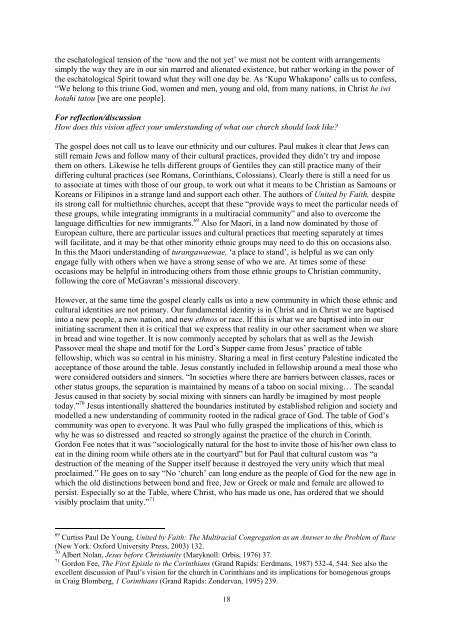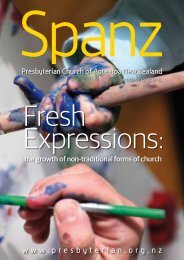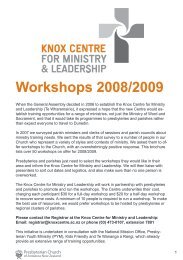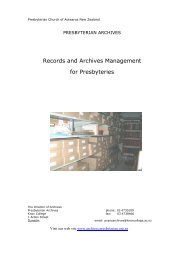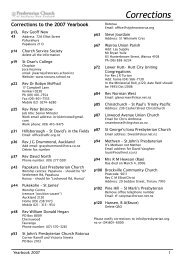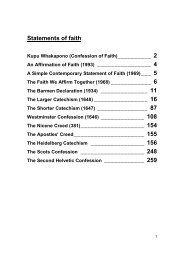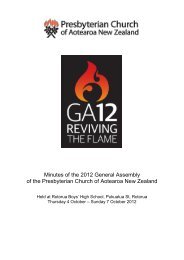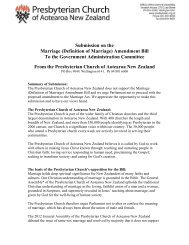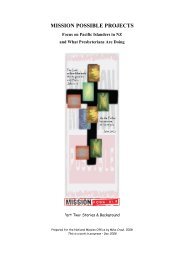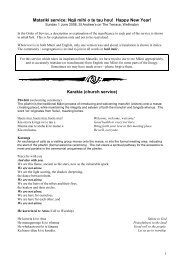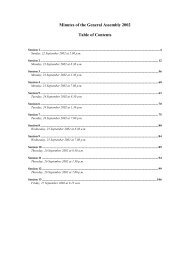Cultural diversity and unity in Christ: the Presbyterian Church of ...
Cultural diversity and unity in Christ: the Presbyterian Church of ...
Cultural diversity and unity in Christ: the Presbyterian Church of ...
You also want an ePaper? Increase the reach of your titles
YUMPU automatically turns print PDFs into web optimized ePapers that Google loves.
<strong>the</strong> eschatological tension <strong>of</strong> <strong>the</strong> ‘now <strong>and</strong> <strong>the</strong> not yet’ we must not be content with arrangements<br />
simply <strong>the</strong> way <strong>the</strong>y are <strong>in</strong> our s<strong>in</strong> marred <strong>and</strong> alienated existence, but ra<strong>the</strong>r work<strong>in</strong>g <strong>in</strong> <strong>the</strong> power <strong>of</strong><br />
<strong>the</strong> eschatological Spirit toward what <strong>the</strong>y will one day be. As ‘Kupu Whakapono’ calls us to confess,<br />
“We belong to this triune God, women <strong>and</strong> men, young <strong>and</strong> old, from many nations, <strong>in</strong> <strong>Christ</strong> he iwi<br />
kotahi tatou [we are one people].<br />
For reflection/discussion<br />
How does this vision affect your underst<strong>and</strong><strong>in</strong>g <strong>of</strong> what our church should look like?<br />
The gospel does not call us to leave our ethnicity <strong>and</strong> our cultures. Paul makes it clear that Jews can<br />
still rema<strong>in</strong> Jews <strong>and</strong> follow many <strong>of</strong> <strong>the</strong>ir cultural practices, provided <strong>the</strong>y didn’t try <strong>and</strong> impose<br />
<strong>the</strong>m on o<strong>the</strong>rs. Likewise he tells different groups <strong>of</strong> Gentiles <strong>the</strong>y can still practice many <strong>of</strong> <strong>the</strong>ir<br />
differ<strong>in</strong>g cultural practices (see Romans, Cor<strong>in</strong>thians, Colossians). Clearly <strong>the</strong>re is still a need for us<br />
to associate at times with those <strong>of</strong> our group, to work out what it means to be <strong>Christ</strong>ian as Samoans or<br />
Koreans or Filip<strong>in</strong>os <strong>in</strong> a strange l<strong>and</strong> <strong>and</strong> support each o<strong>the</strong>r. The authors <strong>of</strong> United by Faith, despite<br />
its strong call for multiethnic churches, accept that <strong>the</strong>se “provide ways to meet <strong>the</strong> particular needs <strong>of</strong><br />
<strong>the</strong>se groups, while <strong>in</strong>tegrat<strong>in</strong>g immigrants <strong>in</strong> a multiracial comm<strong>unity</strong>” <strong>and</strong> also to overcome <strong>the</strong><br />
language difficulties for new immigrants. 69 Also for Maori, <strong>in</strong> a l<strong>and</strong> now dom<strong>in</strong>ated by those <strong>of</strong><br />
European culture, <strong>the</strong>re are particular issues <strong>and</strong> cultural practices that meet<strong>in</strong>g separately at times<br />
will facilitate, <strong>and</strong> it may be that o<strong>the</strong>r m<strong>in</strong>ority ethnic groups may need to do this on occasions also.<br />
In this <strong>the</strong> Maori underst<strong>and</strong><strong>in</strong>g <strong>of</strong> turangawaewae, ‘a place to st<strong>and</strong>’, is helpful as we can only<br />
engage fully with o<strong>the</strong>rs when we have a strong sense <strong>of</strong> who we are. At times some <strong>of</strong> <strong>the</strong>se<br />
occasions may be helpful <strong>in</strong> <strong>in</strong>troduc<strong>in</strong>g o<strong>the</strong>rs from those ethnic groups to <strong>Christ</strong>ian comm<strong>unity</strong>,<br />
follow<strong>in</strong>g <strong>the</strong> core <strong>of</strong> McGavran’s missional discovery.<br />
However, at <strong>the</strong> same time <strong>the</strong> gospel clearly calls us <strong>in</strong>to a new comm<strong>unity</strong> <strong>in</strong> which those ethnic <strong>and</strong><br />
cultural identities are not primary. Our fundamental identity is <strong>in</strong> <strong>Christ</strong> <strong>and</strong> <strong>in</strong> <strong>Christ</strong> we are baptised<br />
<strong>in</strong>to a new people, a new nation, <strong>and</strong> new ethnos or race. If this is what we are baptised <strong>in</strong>to <strong>in</strong> our<br />
<strong>in</strong>itiat<strong>in</strong>g sacrament <strong>the</strong>n it is critical that we express that reality <strong>in</strong> our o<strong>the</strong>r sacrament when we share<br />
<strong>in</strong> bread <strong>and</strong> w<strong>in</strong>e toge<strong>the</strong>r. It is now commonly accepted by scholars that as well as <strong>the</strong> Jewish<br />
Passover meal <strong>the</strong> shape <strong>and</strong> motif for <strong>the</strong> Lord’s Supper came from Jesus’ practice <strong>of</strong> table<br />
fellowship, which was so central <strong>in</strong> his m<strong>in</strong>istry. Shar<strong>in</strong>g a meal <strong>in</strong> first century Palest<strong>in</strong>e <strong>in</strong>dicated <strong>the</strong><br />
acceptance <strong>of</strong> those around <strong>the</strong> table. Jesus constantly <strong>in</strong>cluded <strong>in</strong> fellowship around a meal those who<br />
were considered outsiders <strong>and</strong> s<strong>in</strong>ners. “In societies where <strong>the</strong>re are barriers between classes, races or<br />
o<strong>the</strong>r status groups, <strong>the</strong> separation is ma<strong>in</strong>ta<strong>in</strong>ed by means <strong>of</strong> a taboo on social mix<strong>in</strong>g… The sc<strong>and</strong>al<br />
Jesus caused <strong>in</strong> that society by social mix<strong>in</strong>g with s<strong>in</strong>ners can hardly be imag<strong>in</strong>ed by most people<br />
today.” 70 Jesus <strong>in</strong>tentionally shattered <strong>the</strong> boundaries <strong>in</strong>stituted by established religion <strong>and</strong> society <strong>and</strong><br />
modelled a new underst<strong>and</strong><strong>in</strong>g <strong>of</strong> comm<strong>unity</strong> rooted <strong>in</strong> <strong>the</strong> radical grace <strong>of</strong> God. The table <strong>of</strong> God’s<br />
comm<strong>unity</strong> was open to everyone. It was Paul who fully grasped <strong>the</strong> implications <strong>of</strong> this, which is<br />
why he was so distressed <strong>and</strong> reacted so strongly aga<strong>in</strong>st <strong>the</strong> practice <strong>of</strong> <strong>the</strong> church <strong>in</strong> Cor<strong>in</strong>th.<br />
Gordon Fee notes that it was “sociologically natural for <strong>the</strong> host to <strong>in</strong>vite those <strong>of</strong> his/her own class to<br />
eat <strong>in</strong> <strong>the</strong> d<strong>in</strong><strong>in</strong>g room while o<strong>the</strong>rs ate <strong>in</strong> <strong>the</strong> courtyard” but for Paul that cultural custom was “a<br />
destruction <strong>of</strong> <strong>the</strong> mean<strong>in</strong>g <strong>of</strong> <strong>the</strong> Supper itself because it destroyed <strong>the</strong> very <strong>unity</strong> which that meal<br />
proclaimed.” He goes on to say “No ‘church’ can long endure as <strong>the</strong> people <strong>of</strong> God for <strong>the</strong> new age <strong>in</strong><br />
which <strong>the</strong> old dist<strong>in</strong>ctions between bond <strong>and</strong> free, Jew or Greek or male <strong>and</strong> female are allowed to<br />
persist. Especially so at <strong>the</strong> Table, where <strong>Christ</strong>, who has made us one, has ordered that we should<br />
visibly proclaim that <strong>unity</strong>.” 71<br />
69 Curtiss Paul De Young, United by Faith: The Multiracial Congregation as an Answer to <strong>the</strong> Problem <strong>of</strong> Race<br />
(New York: Oxford University Press, 2003) 132.<br />
70 Albert Nolan, Jesus before <strong>Christ</strong>ianity (Maryknoll: Orbis, 1976) 37.<br />
71 Gordon Fee, The First Epistle to <strong>the</strong> Cor<strong>in</strong>thians (Gr<strong>and</strong> Rapids: Eerdmans, 1987) 532-4, 544. See also <strong>the</strong><br />
excellent discussion <strong>of</strong> Paul’s vision for <strong>the</strong> church <strong>in</strong> Cor<strong>in</strong>thians <strong>and</strong> its implications for homogenous groups<br />
<strong>in</strong> Craig Blomberg, 1 Cor<strong>in</strong>thians (Gr<strong>and</strong> Rapids: Zondervan, 1995) 239.<br />
18


